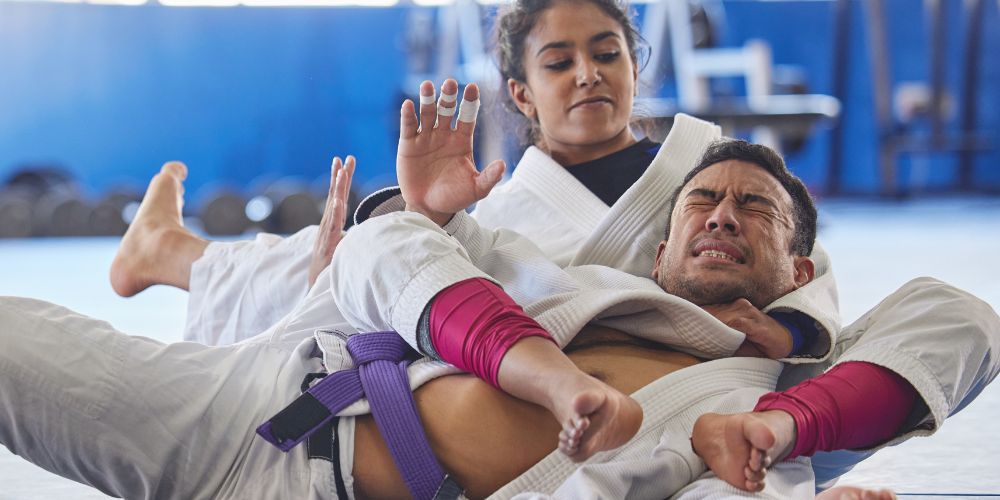BJJ is perhaps the best grappling martial art out there. Still, in its modern sports version, it lacks any form of striking, offensively and defensively. You may be looking into becoming a more well-rounded martial artist by incorporating punching and kicking into your training. But do you know how to split the time between BJJ and striking training?
To effectively split the time between BJJ and striking practice, you need to consider your goals, available time, fitness, and BJJ skill level and then make a schedule that matches all those factors.
Adding striking to your grappling is crucial if you want to be ready for self-defense or MMA, but do you know how to pick the right goals and make an effective schedule for your practice?
Should You Train BJJ and Striking At The Same Time?
The fact is, if you want to be a well-rounded martial artist, you must have skill in both grappling and striking.
As great and effective as a martial art as Brazilian jiu-jitsu is, it is lacking in some areas, and striking is the biggest one in BJJ today. The Gracie family understood the importance of it.
It has always been part of the style they developed because its primary goal was a self-defense and street fighting system that could defeat untrained people and martial artists of all styles.
The best way to do that is by grappling, where the techniques and use of leverage in superior positions can negate huge size disadvantages.
Additionally, most people have at least some natural instinct for how to throw a punch or kick, even if it’s very poorly done. They can always land a lucky shot, but an unskilled person is helpless against even beginner grapplers on the ground.

How to Dominate Every Fight with Raw, Explosive Power No One Can Match
Discover the underground blueprint that has quietly turned MMA hopefuls into legends, using nothing but sheer, brute force and bulletproof conditioning techniques.
But striking is also an inseparable part of fighting. It cannot be ignored while believing you can handle every situation. Mixed martial arts have become the closest equivalent to a real fight we have as a sport.
Even elite BJJ specialists competing in MMA learn and use their striking in the cage, further proving the necessity of both in a fight.
If we can learn anything from judo and karate, the more rules we introduce, the more it becomes a sport rather than a martial art, and BJJ is walking the same path.
Most academies focus solely on sports BJJ, and if you are training at one but want to be more well-rounded, you need to find a way to train BJJ and striking at the same time.
And if you are at an MMA gym or a BJJ school that still teaches self-defense, you are surely already doing some striking alongside your grappling.
How to Split Time Between BJJ and Striking

If you are at one of the Gracie academies still incorporating realistic striking into the curriculum, an MMA gym, or a place where combat jiu-jitsu is a thing, then splitting the time between BJJ and striking is already thought out for you. But if you are not, you must take things into your own hands.
Set Your Priorities
The most important thing you need to do is determine your priorities. If you are reading this, you are most likely a BJJ guy looking to add some striking to his skillset.
This doesn’t need to change, BJJ should still take up most of your training time, but you need to decide how much time you want to allocate to striking.
Time is the biggest restricting factor in any endeavor, and the time you decide to spend drilling punches and kicks will be time not spent on BJJ. First of all, you need to define a clear goal you want to achieve.
Are you training for self-defense? Are you preparing to transition into MMA? Do you like striking and want to improve at a particular style like boxing or Muay Thai? Each of these goals will require different time and effort spent on striking.
The divide will be largely your personal decision, but it should also be according to your skill level. If you are new at BJJ, striking should take a small portion of your time. If you are already advanced, you may afford to dive a bit deeper into the striking by scaling back your BJJ training.
Create A Schedule
Following a schedule is the best way to ensure you are training according to your priorities. The specific schedule can depend on a lot of factors. First, it depends on what classes you have available at your gym.
The best option is to take dedicated BJJ classes involving striking. This type of training will benefit your BJJ effectiveness the most because it is designed to teach grappling with strikes taken into account in all positions.
If there are no such options or you want to reach a higher level of striking, you will have to split the training altogether. Many academies have separate BJJ classes and at least one striking style, usually Muay Thai.
Make your schedule based on your priorities. For example, if you are starting, you may choose 3 BJJ sessions and 1 Muay Thai session per week.
Then, if there aren’t any other classes aside from sports BJJ at your gym, you will have to search for another place to train. Find a boxing, kickboxing, or MMA gym nearby and create a schedule for when you will visit both. Then follow this schedule as strictly as possible.
Balance The Intensity
Making a schedule that allows you to improve in both disciplines is essential. This means it’s best to alternate intensities to let your body recover. For example, if you have a heavy sparring or rolling session one day, it’s not a good idea to follow up with the same thing at the other gym the very next day.
If you can make such a precise schedule, always look to have a light technical training session on the day after your hard training days. This may be difficult to pull off if you are not a high-level athlete with a team behind you, but it’s good advice to follow when possible.
Combining BJJ and Striking

Unless you want to be good at grappling and striking as separate disciplines, the best option is to cross-train and mix the two. Like in MMA and real fights, the two domains are not separated. They are just different elements of a whole working together.
Not only do they work in parallel with each other, but they also complement each other. This is best seen in MMA, where strikes are used to set up takedowns, and ground strikes open up new possibilities for submissions that would be otherwise easily defended.
Vice versa, the danger of a takedown or a submission makes fighters wary and less prepared to defend strikes.
Traditional BJJ understands these concepts well, so strikes have always shortened the distance and got the fight into grappling range.
Perhaps even more important for a grappler is knowing how to defend against the most common strikes effectively. Having the skills in those two striking areas is the only way to become a well-rounded martial artist and for BJJ as a martial art to claim superiority over other styles in a free fight.
If this is your goal, combining BJJ and striking is crucial. The specifics and level you want to take striking will determine how you will split the time between the two.
Should You Learn Striking Or Grappling First
The answer to this question again boils down to personal choice and goals. Striking is more instinctual and will bring faster results, at least to grasp the basics. On the other hand, grappling has a much steeper learning curve and will take some time to learn and get used to.
Then BJJ requires less athleticism and overall fitness, making it easier, to begin with, and building physical attributes gradually.
In general, you need both for self-defense and MMA. Many people suggest you start with grappling and then add striking, but in my opinion, it’s all a matter of goals, preference, fitness level, and, most of all, interest.
If MMA is an indicator, you can build your own unique style of fighting that favors your physical build, mentality, and interests, so you start with whichever you prefer and work from there.
Summary
Splitting the time between BJJ and striking training can be tricky because it depends on many factors. The best idea for a well-rounded skillset is to train them separately at times but also to mix them together because they always work together in a real fight.
Analyze your fitness and skill level, decide how much time you want to spend on striking, and diligently follow your schedule to make progress in all areas.

